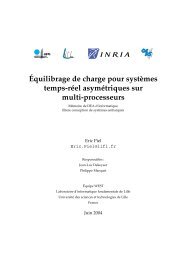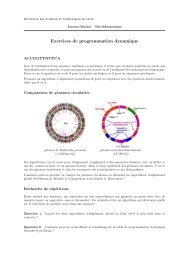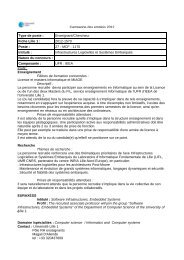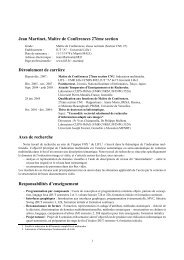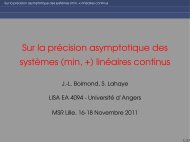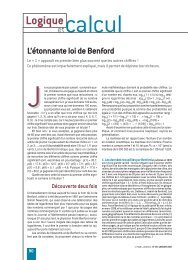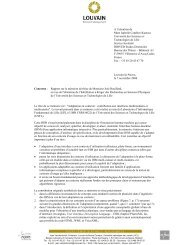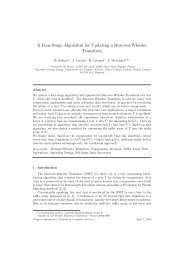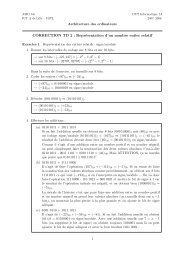Algorithmes de prediction et de recherche de multi-structures d'ARN
Algorithmes de prediction et de recherche de multi-structures d'ARN
Algorithmes de prediction et de recherche de multi-structures d'ARN
You also want an ePaper? Increase the reach of your titles
YUMPU automatically turns print PDFs into web optimized ePapers that Google loves.
38 Chapter 3. Regliss – Locally optimal <strong>structures</strong> <strong>prediction</strong><br />
Figure 3.3-(c) gives an example of <strong>structures</strong> maximal for juxtaposition. The theor<strong>et</strong>ical<br />
upper bound of number of <strong>structures</strong> maximal for juxtaposition is still 3 ℓ/3 . In the example of<br />
Figure 3.4, all locally optimal secondary <strong>structures</strong> are also maximal for juxtaposition. However<br />
in practice, there will be much fewer <strong>structures</strong> maximal for juxtaposition than locally optimal<br />
<strong>structures</strong>. We provi<strong>de</strong> in Section 3.5 experimental measures on a large selection of RNA<br />
sequences (see Figure 3.17).<br />
The link b<strong>et</strong>ween <strong>structures</strong> maximal for juxtaposition and locally optimal secondary <strong>structures</strong><br />
is established by Theorem 1.<br />
Theorem 1 L<strong>et</strong> S be a structure on BP. S is a locally optimal secondary structure if, and only<br />
if,<br />
(i) toplevel(S) is maximal for juxtaposition on BP[1..n],<br />
(ii) for each base pair (x, y) of S, nested(x, y, S) is maximal for juxtaposition in BP[x+1..y−1]<br />
The proof of Theorem 1 will be given in Section 3.2.3, with Lemmas 2 and 3. Figure 3.3-(d)<br />
gives an illustration of the Theorem.<br />
3.2.2 Construction of <strong>structures</strong> maximal for juxtaposition<br />
We show how to efficiently construct the <strong>structures</strong> maximal for juxtaposition. For each pair of<br />
positions i and j of α, we <strong>de</strong>fine the s<strong>et</strong> of secondary <strong>structures</strong> MJ(i, j) as follows.<br />
1. If i ≥ j, then MJ(i, j) = {ε}<br />
2. otherwise, if there exists no base pair of the form (i, y), i < y ≤ j, in BP, then MJ(i, j) =<br />
MJ(i + 1, j).<br />
3. otherwise<br />
MJ(i, j) = � � �<br />
�<br />
(i,y)∈BP[i..j]<br />
(i,y)∈BP[i..j]<br />
{(i, y)} ⊕ MJ(y + 1, j) (a)<br />
Filter((i, y), MJ(i + 1, j)) (b)<br />
⊕ <strong>de</strong>notes the concatenation of a base pair to a s<strong>et</strong> of <strong>structures</strong>: S is in {(i, y)} ⊕ MJ(y+1, j)<br />
if, and only if, there exists S ′ in MJ(y + 1, j) such that S = {(i, y)} ∪ S ′ . In rule (3b), a Filter<br />
function is used to check the maximality of <strong>structures</strong>. It is <strong>de</strong>fined as follows.<br />
Definition 6 (Filter) Given a base pair b, and a s<strong>et</strong> of secondary <strong>structures</strong> R, the secondary<br />
structure S of R is in Filter(b, R) if, and only if, there exists a base pair b ′ in S such that b and<br />
b ′ are conflicting.<br />
In Figure 3.6 for a s<strong>et</strong> of structure R and a base pair b, there is one structure in Filter(b, R).<br />
We have the following Theorem.<br />
Theorem 2 L<strong>et</strong> i and j be two positions on α. MJ(i, j) is exactly the s<strong>et</strong> of all <strong>structures</strong><br />
maximal for juxtaposition on BP[i..j].





